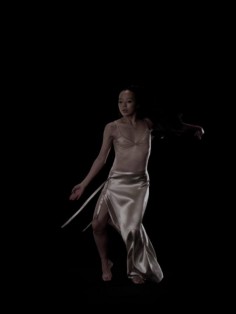DAVID MICHALEK
slow dancing:Fang-yi Sheu
source: davidmichalek
Slow Dancing is a series of 43 larger-than-life, hyper-slow-motion video portraits of dancers and choreographers from around the world, displayed on multiple screens. Each subject’s movement (approximately 5 seconds long) was shot on a specially constructed set using a high-speed, high-definition camera recording at 1,000 frames per second (standard film captures 30 frames per second). The result is approximately 10 minutes of extreme slow motion. The trio of portraits will be randomly selected for each cycle, allowing viewers to simultaneously compare dancers from different styles and cultures.
What at first appears to be a series of still photographs unfolds gesture by barely perceptible gesture—a motion portrait in which each dancer’s unique artistic expression and technique are revealed. Viewers can choose to focus on one dancer’s complete performance or observe the interplay among the screens. The extreme slow motion enables the viewer to share privileged information about the complexity of the simplest gestures, catching details that would normally escape the naked eye.
.
.
.
.
.
.
source: davidmichalek
Slow Dancing est une série de 43 plus grands que la vie, portraits vidéo hyper- ralenti de danseurs et chorégraphes du monde entier , affichés sur des écrans multiples . Le mouvement de chaque sujet (environ 5 secondes ) a été tourné sur un construit spécialement réglée à l’aide , un enregistrement de la caméra haute définition à grande vitesse à 1000 images par seconde ( film standard de filmer en 30 images par seconde) . Le résultat est à environ 10 minutes de ralenti extrême . Le trio de portraits sera choisi au hasard pour chaque cycle, permettant aux téléspectateurs de comparer simultanément les danseurs de différents styles et cultures.
Ce qui au départ semble être une série de photographies se déroule geste par geste à peine perceptible , un portrait de la motion dans laquelle l’expression artistique unique et technique de chaque danseur sont révélés. Les téléspectateurs peuvent choisir de se concentrer sur la performance totale de l’un danseur ou d’observer l’interaction entre les écrans. Le ralenti extrême permet au spectateur de partager des informations privilégiées sur la complexité des gestes les plus simples , la capture des détails qui seraient normalement échapper à l’œil nu.
.
.
.
.
.
.
.
.
.
source: davidmichalek
David Michalek was born and raised in California. He lives and works in New York City. Michalek’s body of work ranges from photography, video and installations, to site-conditioned works of public art. His focus over the past ten years has been closely tied to his interest in the human body and face as sites of meaning, performance techniques, storytelling, movement and gesture. While a student at U.C.L.A., Michalek worked as an assistant to noted photographer Herb Ritts. Beginning in the early-1990s, Michalek began a professional photographic career working as a portrait artist for publications such as The New Yorker, Vanity Fair, Interview, and Vogue. Concurrently, Michalek began to delve into performance, installation, and multi-disciplinary projects. Since giving up commercial photography in 1997, his work has been shown nationally and internationally.


